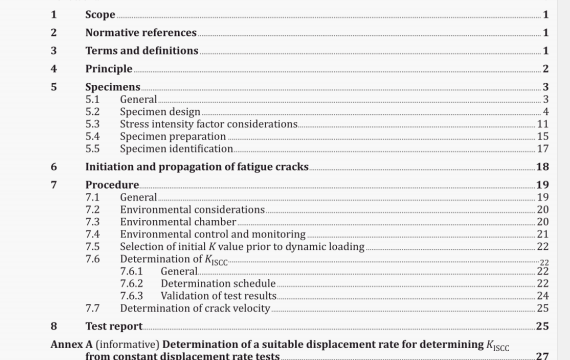ISO 7539-9 pdf download – Corrosion of metals and alloys -Stress corrosion testing – Part 9: Preparation and use of pre-cracked specimens for tests under rising loador rising displacement.
6 Initiation and propagation of fatigue cracks
6.1 The machine used for Fatigue cracking shall have a method of loading such that the stress distribution is symmetrical about the notch and the inaccuracy in measurement of applied load is not greater than ±2,5%.
6.2 The environmental conditions employed during fatigue pre’cracking. as well as the stressing conditions, can influence the subsequent behaviour of the specimen during stress corrosion testing. In some materials, the introduction of the stress corrosion test environment during the precracking operation will promote a change from the normal ductile transgranular mode of fatigue cracking to one which more closely resembles stress corrosion cracking. This may facilitate the subsequent initiation of stress corrosion cracking and lead to the determination of conservative initiation values of K15. However, unless Facilities are available to commence stress corrosion testing Immediately following the precracking operation, corrodant remaining at the crack tip may promote blunting due to corrosive attack Furthermore, the repeatability of results may suffer when pre-cracking is conducted in the presence of an aggressive environment because of the greater sensitivity of the corrosion fatigue fracture mode to the cyclic loading conditions. In addition, more elaborate facilities may he needed for environmental control purposes during pre-criicking. For these reasons, it is recommended that, unless agreed otherwise between the parties, fatigue pre-cracking should be conducted In the normal laboratory air environment.
6.3 The specimens shall be pre.cracked by fatigue loading with an R value in the range 0 to 0.1 until the crack extends at least 2,5 % of Wor 1,3 mm beyond the notch at the side surfaces, whichever is greater. The crack may be started at higher K1 values but, during the final 0,5 mm of crack extension, the fatigue pre-cracking shall be completed at as low a maximum stress intensity as possible (below the expected
NOTE Load shedding procedures as described in ISO 11782.2 can be helpful when the K values are expected to be low.
7.2 Environmental considerations
7.2.1 Because of the specificity a’ metal-environment interactions, it is essential that stress corrosion crack propagation tests are conducted under environmental conditions which are closely controlled (see 72.3 and 72.4).
7.2.2 The environmental testing conditions will depend upon the intent of the test but, ideally, should be the same as those prevailing for the intended use of the alloy or comparable to the anticipated service condition.
7.2.3 Environmental factors of importance arc electrode potential, temperature, solution composition. pH. concentration of dissolved gases, flowrate and pressure. ISO 7539-I provides useful background Information. In relation to gaseous environments a critical factor Is purity of the gas.
7.2.4 Tests may be conducted under open circuit conditions in which the electrode potential of the metal is dependent an the specific environmental conditions of the test, of which the degree of aeration is an important factor Alternatively, the electrode potential may be displaced from the open circuit value by potentiostatic or galvanostatic methods.
7.2.5 Auxiliary electrodes to apply external current should be designed to produce uniform current distribution on the specimen, i.e. the electrode potential should be constant.
7.2.6 When practical, It Is recommended that the specimens be stressed after being brought Into contact with the test environment. Otherwise, the stressed specimens should be exposed to the test environment as soon as possible after stressing.
7.3 Environmental chamber
7.3.1 The environmental chamber shall completely enclose the test section of the specimen. Wherever possible, the gripped portions shall be excluded from contact with the solution environment to prevent galvanic effects and crevice corrosion. These problems can be overcome by the use of a local environmental cell of the type shown in Figure 12 in which the environment Ls circulated around the vicinity of the notch. pre-crack and anticipated crack growth region of the specimen. Crevice problems may also arise where the specimen emerges from the test cell and these should be avoided by appropriate design of the cell or by the use of protective coatings at such locations. If total Immersion In the corrodent is contemplated.
ISO 7539-9 pdf download – Corrosion of metals and alloys -Stress corrosion testing – Part 9: Preparation and use of pre-cracked specimens for tests under rising loador rising displacement
